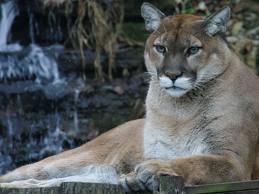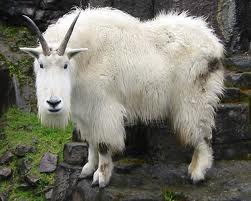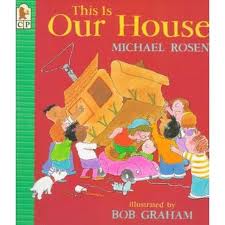Outside Stories and Inside Stories
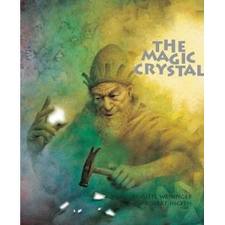
All year long the children in Opal 1 have been enthralled with the idea of a magic crystal. It has been an idea that has come up again and again in their stories at Story Workshop, in their Seed Stories, in their play at Explore, and more. Recently, I happened to stumble upon this book:
The children were excited as I revealed the cover of the story. They wanted to know more about this author's idea of a magic crystal. Would it be similar to theirs? As we finished reading the story, we heard:
“The magic crystal possesses a very special power,” the king explained. Anyone who looks through it sees things in their true light. Look inside, Pico, and know how you really are…”
The children were intrigued by this idea. A magic crystal that could show someone’s inside story. We decided to take this idea and play with it. This story was read right before our trip to the zoo. So as a follow up, we looked at some pictures of the animals at the zoo and tried to imagine: What was their outside story? What could we tell just by looking at them? What was their inside story? What did we imagine they might be thinking or feeling on the inside?
The cougar looks happy but he’s really mad because another cougar ate his prey. ~AG
The cougar looks bored. But his inside story is that he’s happy because someone just gave him a bone to chew on. ~LH
It looks like he wants to eat but really he is just wondering what is happening with the birds. ~RR
The cougar’s outside story is he’s happy. How you can tell is his fur is laying flat. His inside story is he is happy because he loves his surroundings. ~CM
The goat’s outside story is he’s happy but his inside story is that he’s hungry and he’s happy to go hunting for food. ~SB
The goat looks fat. But his inside story is that he is sad because he thinks the other goats think he’s fat. ~LD
He looks sleepy but his inside story is he’s full because he just ate grass. ~BV
It was so much fun to imagine the inside stories of these animals. We wanted to keep playing. To take this idea further we turned to characters in stories. We started by remembering some ideas we had heard earlier in the week:
Teacher: Last week when we were talking about good guys and bad guys after we went to the zoo, ZB said: “there’s no such thing as bad guys” many of you agreed with him, but AG helped us understand by saying about the animals, “It’s just sometimes we don’t understand them.” So today, I’d like to show you an image. What do you notice just by looking at him? What is his outside story?
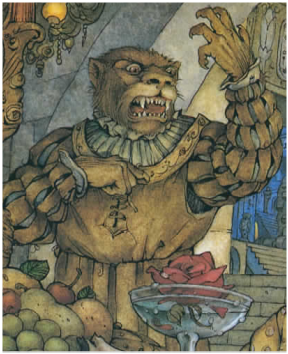
The class created this list to describe his outside story:
Angry, livid, unhappy, furious, mad, frustrated
Teacher: Let’s assume that this character in this story is not a bad guy. That maybe there is just something about him we don’t understand. What might be his inside story?
Then the children had the chance to use materials to see if they could learn some more about the beast by imagining his inside story. We came back together as a group at the end to share:
Teacher: What did you imagine that the beast’s inside story might be? What might be happening to make him so angry?
AG: Maybe his pet ran away with the magic crystal
RR: He’s mad because it’s raining and he can’t take care of his farm
CR: He really wants two crystals and he can’t get them
LG: He was trying to make a fire, but he dropped two fire stones and they fell on his foot and burned him
CM: Maybe somebody threw something at him
NJ: He was trying to go somewhere in his boat, but his boat kept falling apart
ZB: He got shot at and got crushed
BV: Something of his broke
RB: He was mad because when he went back home he saw his favorite things got stolen
MR: He was mad because it started raining and he didn’t like the rain because he didn’t want his fur to get wet and he liked to be dry
LD: Maybe someone threw a block at him
LH: The lady wouldn’t share food with him and he was hungry
CN: A sword stabbed him in the nose
TG: Something hit him or shot him
Wow! The children were really digging into the idea of an inside story. It was amazing that we could all look at the same picture and imagine such different inside stories for why that character might be feeling this way. We wondered what would happen when we tried this idea out on a character in a story we could really relate to. We read a story called This is Our House about a little boy who doesn’t want the other children on the playground to play in the cardboard house he was playing in. Could the children imagine the inside story of someone who it looked like was intentionally excluding others? What would this look like for them? Would they think George was the bad guy? Or could we imagine a different inside story that the author hadn’t told us about.
Teacher: George kept telling people they couldn’t come in his house. It looked like he was excluding. What might his inside story have been?
BV: Maybe he just wanted to play by himself. Because he already played with his friends a lot so he wants some time alone.
CR: Maybe it would explode his house; or he didn’t want to play with them.
AG: George needs his space because he really wanted his space. Once my little brother made my cereal fall over and I just needed some space.
LH: He wanted his alone time because maybe he wanted to eat by his self; he didn’t want anyone to eat any of his snacks.
LD: George thought the other people were going to take his stuff and destroy his house. He was blaming.
LG: He’s feeling calm, but then not very calm. The people really want to go in but if they do, it will get too squished out.
CM: He was worried other people would think his house was dumb.
MR: He feels shy because he’s never met them before. He was worried they were being mean to him.
TG: He just wanted to be alone for a while; he was afraid they would break his house or be mean to him.
They went there. They were able to imagine this little boy in the story and what his inside story might be. They have all felt moments of exclusion before. How powerful to be able to look past the words “you can’t come in” and be able to see that there might be something else going on. That there might be another story we couldn’t see or hear just from “you can’t come in.” The children showed an incredible capacity to empathize with a perspective different from their own initial perspectives. I wondered if this would work if we tried it in our classroom at school. Could we really slow down enough to try this out when we were in the moment of solving a problem? How often were our inside stories hidden from those who are trying to understand us? What if we had some way to see the inside stories of those around us?


